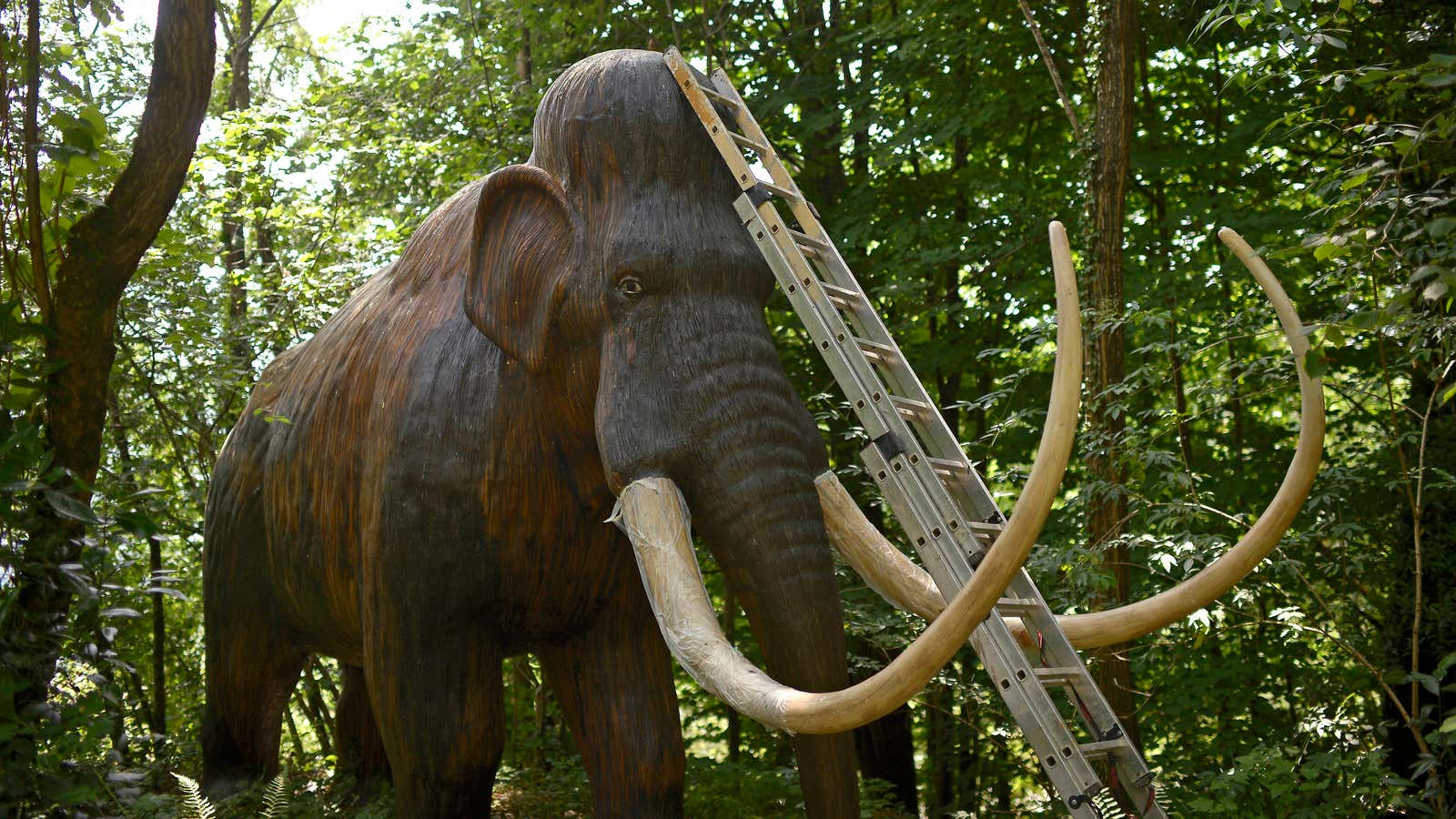A few years ago, bringing back an extinct species was considered science fiction. That’s no longer the case. Developments in cloning and our ability to work with ancient DNA have made some scientists so confident that they claim to be on the brink of achieving the feat.
George Church, a geneticist at Harvard University, recently announced that scientists are leading a “de-extinction” effort that will result in a hybrid mammoth-elephant embryo. This could, in a sense, bring back the ancient beast.
The new woolly mammoth, may not, however, be woolly. In fact, we can’t quite predict exactly what it will be. Church’s project to resurrect the woolly mammoth won’t create an exact replica of the extinct animal. “It would be more like an elephant with a number of mammoth traits,” he told the Guardian.
The genetic hybrid will contain some traits that will be edited into an Asian elephant, which is the closest cousin of the woolly mammoth. Church claims that he has a found a way to include traits for mammoth hair in the hybrid, but there’s no guarantee it’ll work as expected. Would years of effort and tens of millions of dollars be worth the price for a not-so-woolly elephant-mammoth hybrid?
Just because scientists can pull off this feat of genetic engineering, does not necessarily mean that they should. The fear is not that we may be heading towards creating the chaos of Jurassic Park. Dinosaurs lived more than 60 million years ago, whereas the oldest species to yield usable DNA is a 43,000-year-old woolly mammoth.
Instead, spending resources on iconic extinct species, editors at Scientific American have argued, could lead to draining resources that would be better spent on saving species on the verge of extinction:
Already conservationists face difficult choices about which species and ecosystems to try to save, since they cannot hope to rescue them all. Against that backdrop, a costly and flamboyant project to resuscitate extinct flora and fauna in the name of conservation looks irresponsible: Should we resurrect the mammoth only to let elephants go under? Of course not.
There are more than 24,000 threatened species as of 2016, according to the International Union for Conservation of Nature database. Not all of them are as cute as pandas or as majestic as the Bengal tiger, but their existence today contributes to keeping the ecosystem in balance.
Church argues that restoring “keystone” species should not be overlooked. He is, after all, working towards resurrecting woolly mammoths and makes a strong case for why the giants should still be around:
Mammoths could keep the region colder by: (a) eating dead grass, thus enabling the sun to reach spring grass, whose deep roots prevent erosion; (b) increasing reflected light by felling trees, which absorb sunlight; and (c) punching through insulating snow so that freezing air penetrates the soil. Poachers seem far less likely to target Arctic mammoths than African elephants.
Church also argues that work on “reanimation” is not a zero-sum game. Thus, he doesn’t expect resources would be drained from the important work of supporting conservation of threatened species.
Reanimation could help living [animals] by restoring lost genetic diversity. Ancient genes could make [threatened species] more tolerant of chemicals, heat, infection and drought. Just as a new vaccine can free up medical resources that would otherwise be spent on sick patients, reanimation may be able to help conservationists by giving them powerful new tools.
What’s more is that, Adam Welz argues in the Guardian, de-extinction could raise new money to support itself:
Resurrection biology efforts could quite realistically attract donors and investors who have never thought of being involved in wildlife conservation before, but are interested in the awesome novelty of bringing things back to life and the impressive (and perhaps impressively profitable) technology involved. They might even become interested in saving species the old-fashioned way, too.
Enthusiasts argue that, if we have the power, it is a moral imperative that we do what we can to restore the nature that we destroyed. Writer Stewart Brand said at a TED event:
Because the fact is, humans have made a huge hole in nature in the last 10,000 years. We have the ability now, and maybe the moral obligation, to repair some of the damage… some species that we killed off totally we could consider bringing back to a world that misses them.
The case resurrectionists make is tempting. Who wouldn’t want to walk among a parade of woolly mammoths? Journalist and environmentalist George Monbiot wouldn’t. He worries that the exercise would create spectacles and not deliver on any of the environmental promises being doled out.
For any species to be viable, it needs a healthy diversity in its genetic pool. That means, if we want to bring back the passenger pigeon, we’ll need to reanimate hundreds of genetically distinct specimens. We have no idea yet of how to do that, especially when we only have a handful of samples of ancient DNA. Monobiot writes:
The one or two specimens which even the most ambitious de-extinction programs will struggle to produce will live and die in zoos. Or, perhaps, in the private collections of the exceedingly rich people who could fund their revival. The bragging rights, admittedly, would be incomparable. “Come and see my woolly mammoth” must be the world’s greatest lost chat-up line (though it could be horribly misinterpreted).
